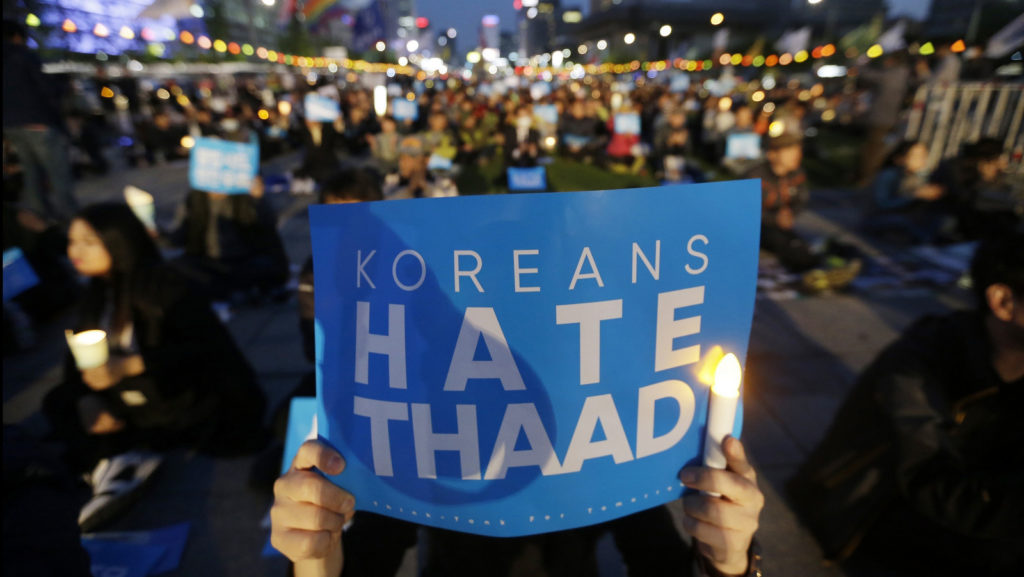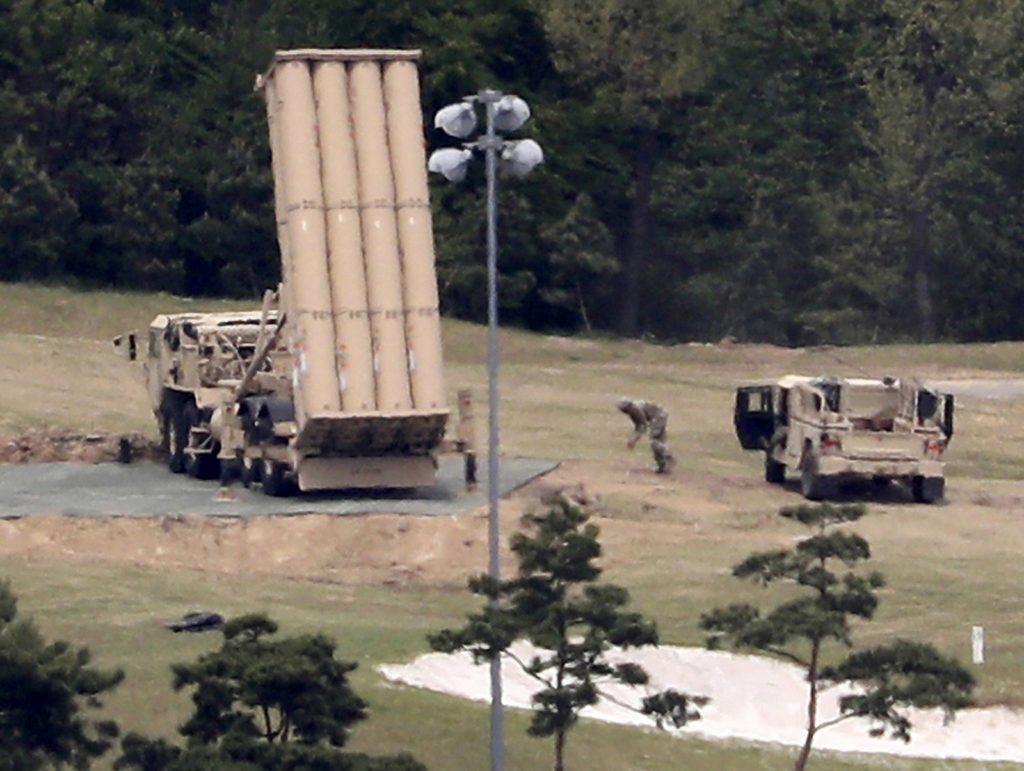S. Korea’s President Orders Probe over Increasingly Unpopular US Missile Launchers
MILITARISM, 5 Jun 2017
Many of South Korean President’s supporters don’t want the missile system, which Donald Trump suggested Seoul should pay for.

South Korean protesters stage a rally to oppose the plan to deploy the advanced U.S. missile defense system called Terminal High-Altitude Area Defense, or THAAD, near the U.S. Embassy in Seoul, South Korea, April 29, 2017. (AP/Ahn Young-joon)
30 May 2017 – Calling it a “very shocking” incident, South Korea’s new president demanded today an investigation into why his office wasn’t told by defense officials about the arrival of several additional launchers for a contentious U.S. missile defense system meant to cope with North Korea’s nuclear threat.
Before taking office on May 10, Moon Jae-in vowed to review the deployment of a system that has infuriated both North Korea and China, which consider its powerful radar a security threat. Many of Moon’s supporters don’t want the system, which U.S. President Donald Trump suggested Seoul should pay for.
On Tuesday, senior presidential adviser Yoon Young-chan said Moon has discovered that four additional launchers for the Terminal High-Altitude Area Defense, or THAAD, system have arrived in South Korea since the original two launchers were installed in April.
Yoon said senior Defense Ministry officials didn’t report the arrival of the additional launchers when they gave Moon’s policy advisory committee a briefing last Thursday.
“President Moon said it’s ‘very shocking’ after receiving a report” on the incident from his national security director, Yoon said at a news conference.
Moon, a liberal, is now working with Cabinet members who were appointed by his conservative predecessor, Park Geun-hye, who was ousted from office in March over a corruption scandal. Moon has nominated some of his own Cabinet members, but they haven’t formally taken office. Moon was sworn in as president right after winning a May 9 by-election, and hasn’t had the usual two-month transition period.

A U.S. missile defense system called Terminal High Altitude Area Defense, or THAAD, is installed on a golf course in Seongju, South Korea. (Kim Jun-beom/Yonhap via AP)
Yonhap news agency cited an unidentified Defense Ministry official as saying the ministry told Moon’s national security director about the four launchers the day after the policy briefing. But Yonhap said the presidential Blue House denied that.
Both the Defense Ministry and the Blue House said they couldn’t immediately confirm the report.
A THAAD battery consists of six truck-mounted launchers that can fire up to 48 interceptor missiles, fire control and communication equipment, and a powerful X-band radar officially known as AN/TPY-2. The THAAD system was installed in the southeastern town of Seongju.
It’s unclear if Moon will go ahead with his campaign pledge to re-examine the THAAD deployment because a request for the withdrawal of the system’s components could severely undermine ties with Washington, Seoul’s most important ally, analysts say. The United States stations about 28,500 troops in South Korea as deterrence against potential aggression from North Korea.
After facing conservative attacks on his security views during the election campaign, Moon toned down his THAAD criticism, saying the deployment would be inevitable if North Korea continued provocations.
Since Moon’s inauguration, North Korea has test-fired three ballistic missiles in an apparent demonstration of its resolve to bolster its nuclear and missile arsenals to deal with what it calls U.S. military threats. Moon has said he will employ both dialogue and pressure to resolve the North Korean nuclear standoff.
Go to Original – mintpressnews.com
DISCLAIMER: The statements, views and opinions expressed in pieces republished here are solely those of the authors and do not necessarily represent those of TMS. In accordance with title 17 U.S.C. section 107, this material is distributed without profit to those who have expressed a prior interest in receiving the included information for research and educational purposes. TMS has no affiliation whatsoever with the originator of this article nor is TMS endorsed or sponsored by the originator. “GO TO ORIGINAL” links are provided as a convenience to our readers and allow for verification of authenticity. However, as originating pages are often updated by their originating host sites, the versions posted may not match the versions our readers view when clicking the “GO TO ORIGINAL” links. This site contains copyrighted material the use of which has not always been specifically authorized by the copyright owner. We are making such material available in our efforts to advance understanding of environmental, political, human rights, economic, democracy, scientific, and social justice issues, etc. We believe this constitutes a ‘fair use’ of any such copyrighted material as provided for in section 107 of the US Copyright Law. In accordance with Title 17 U.S.C. Section 107, the material on this site is distributed without profit to those who have expressed a prior interest in receiving the included information for research and educational purposes. For more information go to: http://www.law.cornell.edu/uscode/17/107.shtml. If you wish to use copyrighted material from this site for purposes of your own that go beyond ‘fair use’, you must obtain permission from the copyright owner.